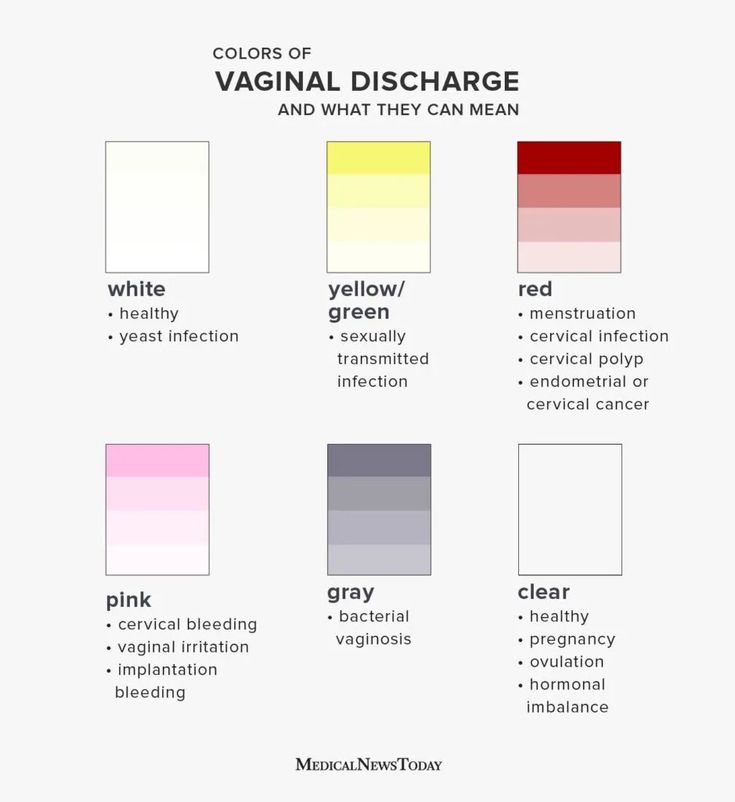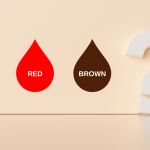
As the menstrual cycle progresses, your body undergoes hormonal shifts and physical changes that continue throughout the cycle, including in vaginal discharge at different phases. Vaginal discharge (cervical mucus) before your period is common and provides clues about your body. For example, it might mean your period is about to start or signal underlying conditions, which can include changes related to fibroids.
Fibroids affect different aspects of the menstrual cycle, in various ways, and some of these can influence vaginal discharge including the color, consistency, scent, and the amount of vaginal discharge.
Types of Vaginal Discharge
Recognizing the difference between normal and abnormal discharge before your period is important to understanding menstrual health.
Egg White Discharge Before Period
- Texture: Stretchy, clear, and slippery.
- Indicates ovulation and peak fertility.
- Normal and healthy cervical mucus production.
Thick White Discharge Before Period
- Texture: Sticky, clumpy, or pasty
- Typical sign of hormonal shifts.
- Itching or a cottage cheese-like texture may indicate a yeast infection.
Clear Discharge Before Period
- Texture: Watery, runny, and transparent.
- More common during the follicular phase (early in the cycle)
- Maintains vaginal lubrication.
Sticky Discharge Before Period
- Texture: Tacky or glue-like.
- Usually before ovulation and after menstruation.
- Less fertile type of cervical mucus.
What Color Is Discharge Before a Period?

The color of vaginal discharge before your period can vary from person to person, but there are normal vs. abnormal discharge colors to look out for that can be a result of underlying conditions such as uterine fibroids.
Normal Discharge Color Before Period
- White discharge: Can be cream or pale yellow and usually indicates good lubrication if there are no other symptoms.
- Clear discharge: Typically caused by ovulation or hormonal fluctuations.
- Pink Discharge: This discharge can be bright or dark pink and contains a small amount of blood. Spotting before menstruation is the most prevalent cause of the pink discharge, although it can also indicate implantation bleeding in early pregnancy.
Abnormal Discharge Color Before Period
- Red Discharge: Ranging from bright red to a dark, rusty color, can indicate several possible causes. One potential reason is related to fibroids, where changes within the fibroid, called fibroid sloughing or degeneration, can cause this type of discharge.
- Yellow-Green Discharge: A slight yellow discharge before your period may not indicate a problem, as it can be caused by dietary changes or the use of dietary supplements. However, STIs can cause a yellow-green discharge, often accompanied by a fishy odor and itching.¹
- Gray Discharge: A potential sign of bacterial vaginosis, a frequent bacterial infection (BV). Other vaginal symptoms associated with BV include itching, discomfort, a strong odor, and redness around the vulva or vaginal opening.²
Potential Causes of Abnormal Discharge Before Period
Uterine Fibroids
Fibroids, particularly submucosal and some intramural types, can sometimes cause irregular discharge before a period. They can lead to heavy or prolonged bleeding, spotting between periods, or pink discharge due to their physical impact on the uterus. While they are influenced by hormone levels, they don’t typically cause significant hormonal shifts. However, their presence can result in changes to the consistency and volume of cervical mucus before your menstrual period.
Are fibroids causing your symptoms? Take the quiz to find out.
Yeast infection
Yeast infections, also known as candidiasis, are common in women. With a yeast infection, the vaginal discharge before your period is usually thick, white, and lumpy, similar to cottage cheese, alongside symptoms like itching and burning in and around the vaginal area. These infections are often triggered by antibiotic use, hormonal changes from birth control, or pregnancy.
Hormonal birth control
Hormonal birth control, especially methods that contain estrogen, can lead to increased vaginal discharge. This is usually a normal side effect unless accompanied by other symptoms.
Pregnancy
An increase in discharge before your period can also be an early sign of pregnancy due to elevated estrogen levels. This discharge may be white or slightly yellow and sticky. Other early pregnancy symptoms include a missed period, breast tenderness, nausea, fatigue, and frequent urination.
Bacterial vaginosis
Bacterial vaginosis (BV) is an infection caused by bacterial imbalances in the vaginal canal that affects anywhere between 23 to 29% of women of reproductive age.³ Having multiple sexual partners is connected to BV. The discharge is grayish-white in color with a fishy stench.
Sexually transmitted infections (STIs)
Changes in vaginal discharge result from various STIs, including chlamydia, gonorrhea, and trichomoniasis.
How Your Menstrual Cycle Affects Discharge

Before your menstrual cycle, you may notice a white discharge called leukorrhea. Leukorrhea helps cleanse the vagina and contains fluids and cells naturally released by the body. When there is increased estrogen production, the discharge may appear transparent or yellow and can be stretchy or watery.
When estrogen levels are at their highest, your cervix releases leukorrhea. When your hormone levels drop, you may have thick, pasty discharge or none at all. This type of discharge is produced just before and during ovulation.
Phases of the Menstrual Cycle & Discharge
The average menstrual cycle lasts around 28 days, but can vary cycle to cycle.
Typically, your cycle goes through four phases:
- Menstruation (Period): The first day of your cycle is when the lining of your uterus sheds and exits your body as your period, mixing with your cervical mucus. This usually lasts three to seven days.
- Follicular Phase (Days 1-14): This phase typically lasts around 14 days and is fueled by rising estrogen levels. During this phase, the follicles (tiny sacs in your ovaries) mature, each containing an egg, with minimal to no discharge for the first three to four days. Afterward, a hazy, white discharge may occur.
- Ovulation is a brief window, around 24 hours, in the middle of your cycle (around day 14 in a 28-day cycle): A hormone surge triggers an egg’s release from the dominant follicle. After the egg is released from the ovary into the fallopian tube, more discharge may appear. It’s usually thin, slick, wet, and easily stretches between your thumb and forefinger.
- Luteal Phase (Days 15-28): This phase lasts about 14 days after ovulation, with progesterone becoming the dominant hormone. This phase prepares the uterine lining (endometrium) for a possible pregnancy. If pregnancy doesn’t occur, progesterone levels drop, triggering menstruation and restarting the cycle.
What Causes Discharge Before Your Period?
Vaginal discharge before your period or during any part of your cycle can be caused by several factors such as hormonal fluctuations, changes in cervical mucus, and natural shifts in your menstrual cycle. For example, an increase in progesterone—a hormone involved in the menstrual cycle and pregnancy—can cause discharge before your period to appear hazy or white. However, if the discharge is an unusual color or accompanied by symptoms such as itching, it may be a sign of an underlying condition.
The Impact of Fibroids on Menstruation & Discharge Before Your Period
Women with fibroids are more likely to experience abnormal menstrual cycles, including irregular discharge, before their period. Understanding what is considered normal versus abnormal can help determine when to seek medical evaluation.
How Fibroids Affect Your Menstrual Cycle
- Heavy Bleeding: Fibroids can cause heavier periods with prolonged bleeding, lasting 10 days or more.
- Spotting Before Your Period: Fibroids can cause irregular bleeding or spotting between periods, which differs from pre-period discharge. Spotting before your period may appear as light bleeding or pink discharge, signaling hormonal changes or fibroids.
- Increased Pain: This pain can cause further discomfort and cramping with heavy bleeding.
- Unusual Discharge: While discharge before your period is normal, any significant changes in color, consistency, or foul odor may indicate an infection separate from fibroids.
Many with fibroids are unaware, as they believe heavy, lengthy periods or severe cramps are a normal part of their cycle. However, if you have heavy periods accompanied by other fibroid symptoms, such as a protruding abdomen or constipation, it is time to consult a specialist to determine the cause.
Fibroid-Related Discharge vs. Normal Vaginal Discharge
| Symptoms | Normal Discharge | Fibroid Discharge |
| Color | Clear or white | Dark red, brown, or pink |
| Consistency | Thin, watery, or egg-white | Thick, clotted, or watery |
| Spotting | Occasional, related to ovulation | Light bleeding that occurs outside the regular period |
| Volume | Moderate increases during ovulation | Heavy discharge with possible blood clots |
How Fibroids Affect Discharge Before Your Period
While natural hormonal fluctuations primarily drive the cyclical changes in cervical mucus before your period, uterine fibroids can sometimes influence vaginal discharge. Some individuals with fibroids might experience an overall increase in watery or heavier vaginal discharge at various points in their cycle, including potentially before their period. This is often due to the fibroids’ physical presence and potential irritation within the uterus.
However, fibroids are not typically a direct cause of significant changes in the consistency of cervical mucus, unlike normal hormonal shifts that occur before menstruation. Any unusual bleeding or persistent changes in discharge, such as pink or brownish tinges, should be discussed with a healthcare provider to determine the underlying cause.
Consult a fibroid specialist for personalized treatment and guidance if you notice abnormal discharge or other symptoms.
Meet With a Fibroid Specialist
How to Monitor Your Discharge & Menstrual Health
Tracking changes in cervical mucus before your period or other menstrual patterns can provide insight into your reproductive health, such as whether the symptoms you’re experiencing are related to fibroids.
Some methods you can use to monitor these patterns include:
- Menstrual Tracking Apps: Offer a range of features to help users track their periods, predict ovulation, log symptoms, and gain insights into their bodies.
- Noting Persistent Symptoms: Pay attention to prolonged spotting, irregular bleeding, or unusual discharge (changes in color, consistency, or odor).
- Seeking Medical Advice: If discharge changes suddenly, has a strong odor, or is accompanied by pain, consult a health specialist.
At USA Fibroid Centers, our fibroid specialists help those with fibroids through education and treatment. Our specialists are experts in uterine fibroid embolization (UFE), a minimally invasive outpatient procedure for treating fibroids. UFE can help eliminate symptoms and preserve your uterus, allowing you to return to your daily routine with minimal downtime.
Learn more about UFE by booking a consultation using the button below or by calling 855.615.2555.
Common Questions About Premenstrual Discharge
What Is White Discharge Before Your Period?
White discharge before your period is usually cervical mucus thickening in response to hormonal changes, which helps protect the reproductive system. The volume and quality of the discharge vary, with some women having barely any while others may have up to a teaspoon. It can also be creamy or transparent, like an egg white, and it is not necessarily totally white.4 However, fibroids can lead to more noticeable discharge due to their influence on menstrual patterns.
What Causes a Sticky Discharge Before a Period?
A sticky, white, or clear discharge before your period is normal, resulting from hormonal fluctuations, such as the rise in progesterone after ovulation. This hormonal shift thickens cervical mucus, typically during the luteal phase, which occurs between ovulation and menstruation.
How Can I Tell if My Discharge Before My Period Is Normal or a Sign of Pregnancy?
Discharge before your period and early pregnancy are similar but have key differences. Before your period, you may notice a slight increase in discharge, which is usually white, clear, or slightly yellowish. During early pregnancy, discharge increases but tends to be thicker and more white in color. Additionally, a potential early sign of pregnancy is light pink spotting, known as implantation bleeding.
How Do Yeast Infections Affect Discharge?
Yeast infections often cause thick, white vaginal discharge resembling cottage cheese, typically accompanied by itching and a burning sensation in the vaginal area. Hormonal changes, especially those that occur before menstruation, can increase the risk of yeast infection by disrupting the natural balance of bacteria and yeast. Other contributing factors include the use of antibiotics, birth control pills, and pregnancy.
How Can I Avoid Vaginal Infection Risks?
There are lifestyle changes you can make to avoid abnormal vaginal discharge before your period or at other points in your cycle. One option is to use unscented products around your vaginal area, as scented ones can disrupt the natural balance and cause irritation. Using protection during sexual activity, like condoms, supports vaginal health and guards against STIs. Additionally, managing menstrual care by regularly changing pads or tampons according to your flow helps prevent bacterial buildup.
When Should I See a Doctor About Changes in Vaginal Discharge?
If you experience unusual discharge or changes in cervical mucus before a period, along with other symptoms, consult a doctor or specialist. Persistent spotting or abnormal bleeding may be caused by fibroids and require professional diagnosis and treatment.
Sources
- Nicole Galan, ed. Tahirah Redhead, “Vaginal Discharge Color Guide: Causes and When to See a Doctor,” Medical News Today.
- Jayne Leonard, ed. Cynthia Cobb, “White Discharge before Period: Causes and Other Colors Explained,” Medical News Today.
- Erica Cirino, “Cervical Mucus: An Early Pregnancy Sign?” Healthline.
- Toketemu Ohwovoriole, ed. Irena Cabrera, “White Discharge Can Be a Sign of Your Period or Something More Serious – Here’s How to Tell,” Business Insider.



